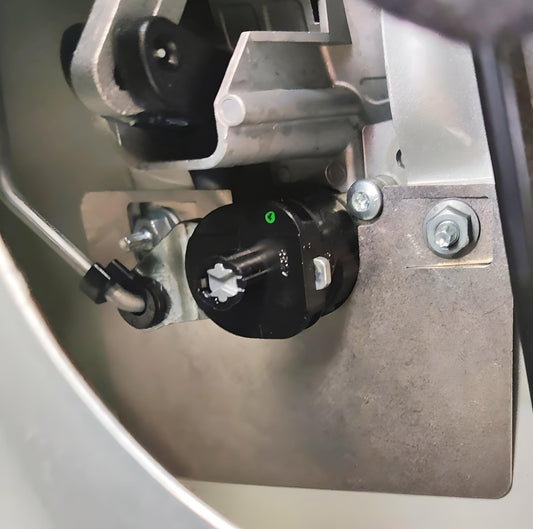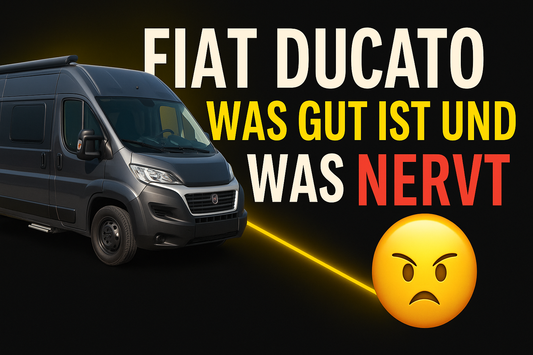Deciding on a base vehicle is probably the most important decision when it comes to camper conversions. Once you have made the purchase, the vehicle determines all further steps: the type of conversion, the level of comfort, the options for adding extra weight and, last but not least, the travel experience for many years to come. In our case, the path led us from the caravan to the Peugeot Boxer L3H2 - and this article describes why we made exactly this decision, what stumbling blocks we encountered along the way and what we would do differently in hindsight.
This article is not only a short story about our own camper, but also a guide for anyone who is currently facing the same decision. Because in the end, it is the many small experiences that decide whether you are satisfied in the long term.
From caravan to panel van - why we had to change
Our starting point was a caravan. It was the ideal solution for permanent camping: plenty of space, fully equipped, fixed furniture and a real home on wheels. As long as we had a permanent pitch there, it was perfect.

But when we gave up the pitch, the disadvantage quickly became apparent: You're not flexible with a caravan. Every trip started with us having to drive to the pitch to load the caravan. Spontaneous weekends or city trips were hardly possible, and it was simply too impractical for short trips.
So it was clear to us that we needed a more compact vehicle - flexible enough for traveling and everyday life, but with enough space for the three of us.
Searching the market - standard models didn't fit
We initially looked around the market for new and used panel vans from well-known manufacturers. But the selection was sobering:
- After Corona, used ones were extremely rare.
- New vehicles had delivery times of a year or more.
- Almost only former rental vehicles that were sold at the end of the season were available.
Some of these came into question, but had decisive disadvantages for us:
- Bunk beds: practical, but there was far too little headroom in the lower bed.
- Dinette conversions: Combining the rear bench and front seats into a bed - we didn't want to convert every night.
- Mattress above the cab: also common, but not a permanent solution for us.
So it was clear: we would convert our vehicle ourselves to have three permanent sleeping places without having to convert it.
Opting for the panel van
In terms of vehicle class, we opted for a panel van with a length of around 6 meters:
- Compact enough for cities and parking lots.
- Large enough for the bed, seating area, kitchen and storage space.
- H2 height for full headroom in the interior.
This left the Peugeot Boxer L3H2 as the best base - identical in construction to the Fiat Ducato and Citroën Jumper.
Alternative base vehicles
We also looked at the Mercedes Sprinter, VW Crafter, Opel Movano and Renault Master. But they all had the same disadvantage: too narrow for a transverse bed, poorer ratio of external length to usable internal length.
We also considered an L3-H3, i.e. slightly longer and higher. However, we only found an L4-H3 (approx. 6.40 m) on the second-hand market. That was too long for us - we wanted to stay under 6 m.
What does Sevel mean?
The Ducato, Boxer and Jumper vehicles come from the Sevel (Società Europea Veicoli Leggeri / Société Européenne de Véhicules Légers) plants. This joint venture between Fiat and PSA has been producing light commercial vehicles since 1978. Thanks to the cooperation, the models are identical in construction - an advantage when it comes to upgrading, as there are many accessories and experience available.
The vehicle in detail
In the end, we opted for a:
- Peugeot Boxer L3H2
- 2.0 HDI with 131 hp
- Light chassis with 3.3 t permissible total weight
- Three years old, 157,000 km
Equipment
The decisive factors for us were
- Passenger airbag - hard to find, but safety-relevant.
- Automatic air conditioning - not a must, but noticeably more comfortable than a simple air conditioning system.
- Reversing camera - seemed sensible, but proved to be of little use (original camera of poor quality, later replaced).
Engine choice - what we learned
2.2-liter Puma engine - problematic
This engine was also installed in the Ford Transit/Nugget and is considered vulnerable. Many advise against buying it. It is often referred to as a problem engine in forums. It was installed in the Peugeot Boxer and Citroen Jumper, not in the Ducato.
2.0-liter HDI - our choice
Our 2.0 HDI runs reliably. Only the AdBlue metering valve was defective once, but it was inexpensive to repair. A well-known issue: the entire AdBlue system, especially the tanks.
We ourselves have been lucky so far: we have been spared the tank problem. Maybe it's because we've been using a Tunap additive since the beginning as a precaution. The product is also available from Amazon(Tunap AdBlue additive) - note: advertising link. I can't say for sure whether it really helps, but the fact is that we haven't had any new problems since we started using it. As the costs are low, we use it consistently.
Another point is the quality of the AdBlue itself. Many users report that problems with the system can also be caused by low-quality AdBlue from the DIY store or supermarket. We therefore adhere to the recommendation not to buy canister AdBlue from discount stores. Instead, we only fill up at the filling station, where the throughput is high and the quality is right.
2.3-liter Multijet - the recommendation for the Fiat Ducato
Many consider the 2.3-liter diesel (Iveco F1A) to be the best choice: solid, durable and robust. However, it was much harder to find on the used market at the time.
3.0-liter diesel - very robust, but discontinued
The 3.0-liter diesel (Iveco F1C, Multijet/3.0 HDi) is considered extremely robust. However, it was discontinued around 2016 - presumably for reasons of emissions and efficiency. Today, vehicles with this engine are only available second-hand, mostly from model years up to 2014/2015. Prices are correspondingly high and supply is scarce.
Chassis: Light vs. Maxi - more than just weight
We opted for the light chassis with 3.3 t. In hindsight, a decision with light and shade.
Advantages of the Light chassis
- Approx. 40-50 kg lighter than the Maxi.
- Some versions are fitted with 16-inch wheels - this noticeably improves ride comfort.
Disadvantages of the Light chassis
- Usually only 15-inch wheels as standard → bumpier, poorer comfort and the registration of 18-inch rims is hardly possible, at least in Austria.
- Weaker brakes.
- No possibility to add as much weight as with the Maxi, but that is irrelevant for us.
Our approach: We later increased the load to 3.5 t with additional air suspension. This works, but it is time-consuming.
Experience after several years
- The vehicle size (L3H2, 6 m) is perfect for us: easy to handle and still plenty of space.
- The engine runs reliably, with the exception of minor AdBlue issues.
- The running gear with the light chassis was not ideal, but could be corrected by adding weight.
- Features such as automatic air conditioning and passenger airbag proved their worth, the reversing camera was superfluous.
-
Engine selection:
- 2.2 l Puma diesel: problematic, better to avoid.
- 2.0 l HDI: solid, keep an eye on AdBlue. Additive such as Tunap can help (advertising link).
- 2.3 l Multijet: highly recommended, harder to find.
- 3.0 l Multijet: robust, but only in older model years (up to approx. 2016).
- Chassis: Light (lighter, but bumpier) vs. Maxi (better comfort, reserves, brakes).
- Note the width: Transverse bed practically only possible with Ducato/Boxer/Jumper.
- Plan length realistically: Under 6 m → more flexible & cheaper; 6.40 m (L4H3) bulkier.
- Equipment: Automatic air conditioning provides comfort, passenger airbag is rare but recommended.
Conclusion
Our decision in favor of the Peugeot Boxer L3H2 was exactly right. It combines suitability for everyday use with the space we needed for our expansion.
Not everything went perfectly - in hindsight, we should have gone for the Maxi when it came to the chassis. But overall, the vehicle suits us perfectly. The engine is reliable, the size is suitable for the city and for traveling, and the equipment has proven itself.
Most importantly, we now have a vehicle that gives us the freedom to set off spontaneously - without detours via parking spaces, without long rearrangements. This freedom was precisely our goal, and we have achieved it with our Boxer.





